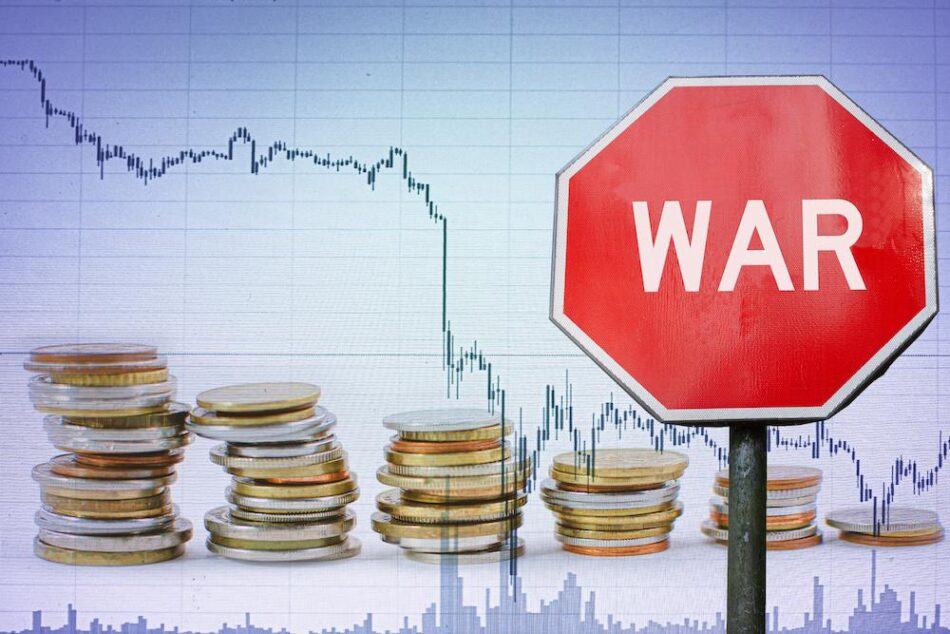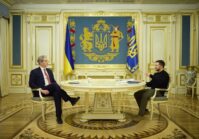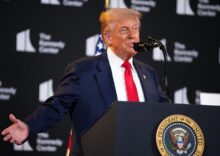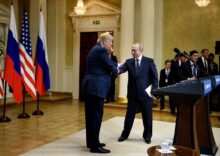Winning the Economic and Financial War in Ukraine.


In advance of expected talks upon Trump’s presidency in early 2025, “land for peace” has become the catchphrase uttered by those who want a quick end to the war. Central among the innumerable complications with this formulation is that Putin is not fighting for land, but for the destruction of the Ukrainian state as a whole. His war aims and methods extend far beyond military victories on the battlefield.
As a result, we in the West would be foolish to strengthen Ukraine against Putin’s multidimensional attacks with a narrow focus on the military security aspect. We must meet Putin on the other fronts as well.
Nearly as vital as military defense is to Ukraine’s independent, Western future is the war being fought on the economic and financial front. While the West should be praised for its solid financing of the Ukrainian budget these last 3 years, much more can and should be done. For the benefit of Ukraine and the West, we need to consider several novel concepts to achieve “peace through strength.”
Ukraine’s Faltering Path
Despite Ukraine’s formal independence in 1991, Russia’s subjugation of the Ukrainian state in fact continued well past the dissolution of the Soviet Union. And, until 2014, Moscow never had to fire a bullet. Moscow’s continued domination of Ukraine in fact originated in the financial and economic spheres.
After the collapse of the USSR, Ukrainians did not opt for the path of “shock therapy” and its attendant open international financial flows. Instead, they chose what proved to be the less painful path in the short term though catastrophic over the long term – the dominance of state-owned enterprises, government subsidies for the population, and capital markets virtually closed to foreign capital.
As a result, the majority of these state-owned enterprises became privatized for a pittance by those with access to the right government connections. Unsurprisingly, those with access were linked to Moscow. Without sizeable Western capital investments, the population became poorer each year, and the country failed to detach itself from Russia’s sphere of influence.
Bringing us to today, we still have a situation where the majority of capital in Ukraine is of Oligarchic-russian origin. Even new companies created in the last decade or so – such as Rozetka and Nova Poshta, with capitalization in the hundreds of millions of dollars – do not have enough clout to challenge the status quo and must play by the rules of Oligarchic-russian capital.
Naturally, the implications of this Oligarchic-russian dominance is self-evident. Rather than rule of law, we have the law of rulers – a system that rewards loyalty over competence. Unsurprisingly, the system thus attracts not the best and the brightest, but the most unprincipled and obedient to these rulers/owners. These Oligarchic-russian owners require their politicians, civil servants, judges, law enforcement officers, and even their own employees to not only be corrupt but also demonstrate a capacity to corrupt others. Such a system then ensures the protection of the prevailing capital of the existing vested interests while keeping Ukraine closed to clean, western capital.
Current Opportunity
After the full-scale invasion, we now have a unique opportunity where russian influence on the Ukrainian market will be greatly reduced for at least a generation. It is extremely important for both Ukraine and our Western allies to use this window of opportunity – the first in some 300 years – to replace the Oligarchic-russian capital with clean, western financing.
There is little need to explain why a turn westward is more desirable. Our nation will benefit from higher quality jobs, Western businesses intent on paying taxes rather than avoiding them, greater adherence to ESG and DEI standards, and, most importantly, foreign investors demanding completely different qualities of those in power – professionalism, integrity, transparency, and zero tolerance for corruption. A far more just society can prevail as a result, overturning the hopeless inequity of the past three decades.
In order to achieve this, a strategic goal of attracting at least $100-200bn of private western investment during the first 10 years after the end of the active phase of the war must be set. Aside from the obvious economic and financial benefits of such inflows of capital, this investment would serve a security purpose as a financial bulwark deterring any future Russian aggression. Put simply, if Western private and public interests have billions invested in Ukraine, the political compulsion to provide the required security guarantees would be reconfirmed. Conversely, a failure to open the country up to western interests ensures that russia will in time inevitably be tempted to once again subjugate Ukraine as soon as Moscow has rebuilt its military capability.
We can avoid a third russian invasion if we take the right economic and financial measures now.
Subsidies for Western Capital
Tax payers in allied countries are currently keeping the Ukrainian economy afloat, with outright aid and subsidized loans to the tune of ~$40 billion a year. While enormously appreciated and needed, this external support creates a situation where the economy seemingly continues to operate at roughly the levels seen before the war, and thus there is no distressed pricing on commercial assets in Ukraine.
Though positive for existing local players, this continuity is unattractive for potential new foreign entrants – nobody wants to invest in a war zone where returns on investment are 15-20% per annum. Thereby, Western support to the Ukrainian budget effectively crowds out potential private investment.
Thus, rather than continuing to funnel all this foreign support directly into the budget, the investment environment can improve much faster if financing is offered in the form of subsidies for western investors, enticing those businesses to enter Ukraine now or soon after the end of hostilities.
Had this policy been embraced earlier, we would already have seen the difference. Recently, a large titanium mining interest in the Mykolayiv region, OGKH, was privatized by Ukraine for $200 million, with the sole bidder being an Azerbaijani owned private equity firm. Imagine if instead a western company chose to apply, with the help of a facility subsidizing western businesses. The company could have put down, for example, $20mn and western taxpayers $180mn. The Ukrainian government would have received the same $200mn in proceeds, but the ownership of the strategic mining interest will be in the western, and not russian, sphere of influence. Additionally, rather than just injecting $180mn into the Ukrainian budget directly, as is being done now, the same subsidy would have had the additional desirable effect of a western company invested in Ukraine which would not have entered otherwise.
The same subsidies can be applied to green field projects in Ukraine. Subsidizing 30-50% of capital expenditure for reputable western firms in Ukraine will increase their ROI to 30%+ rates, which will make projects both attractive commercially and, most importantly, will be achieving the goal of bringing clean capital to Ukraine.
In order to achieve the goal of, for example, $20 bn of western FDI to Ukraine per year, an annual subsidy of $5-7 bn may be needed – admittedly, a large amount but with much better and lasting side benefits than just sending the same amount of money to the Ukrainian budget.
Opening up the Banking Sector
Another important step to facilitate inflows of Western FDI is simply removing capital controls to open up Ukrainian capital markets to western capital, something that has not been done over the last 30 years. The National Bank of Ukraine has deliberately kept the local currency, hryvnia, nearly non-convertible to keep the local capital in and the foreign capital out. Once this is achieved, the banking sector needs to be liberalized in order to thrive.
A historical parallel to Europe is relevant here. During the creation of the EU, one of the major reforms was the concept of “EU passporting” for banks. As a result, a bank in one EU country can offer services and open branches to customers in any other EU country, without having to obtain a new banking license in that country. Effectively, the bank simply notifies the local regulator that it is now operating in its jurisdiction, while the local regulator has no authority directly over the bank and can only ask the home regulator of the bank if it has any questions about the activities of the bank. The benefit to the EU banking sector has been massive, similar to the “big bang” of opening UK financial markets to foreign players during Margaret Thatcher’s era.
We propose that western allies strongly demand that Ukraine opens up its banking sector to EU/UK banks as soon as hostilities end (at the latest). Moreover, banks of allied nations, such as US/Japanese, will not be discriminated against as most of them have EU subsidiaries that will be able to operate in Ukraine.
There is very little downside to this opening up of the market, since roughly 80% of the banking sector in Ukraine is currently state-owned. Instead, the opposite is true: by easing access to local retail and business customers for EU banks, Ukraine will actually create interest in acquiring these state-owned banks, even if after purchase they operate not under the National Bank’s license but in German or British regulatory space. This will also force the NBU to reform it’s regulatory policy, bringing it into greater alignment with EU regulators.
Lastly, in advance of Ukraine’s eventual accession to the EU when bank passporting operates by default, the process should begin now in order to start easing the barriers of entry for FDI to Ukraine.
Making Russia Pay & Direct Procurement for Western Businesses
Long term victory of Ukraine has two components: attracting western capital to Ukraine, and cutting russia away from the same western capital and trade markets. The former has been addressed above.
The latter can be achieved by various means. For starters, Western governments and financial institutions should force all publicly-listed companies in western markets to declare how much taxes they, or their subsidiaries, pay in russia and create a “war sin tax” surcharge where they pay 50 cents to the Ukraine reconstruction fund for every dollar they pay to the russian budget. This mechanism of disclosure is very easy to enact, and cheap for publicly-listed companies to implement as they already know down to the penny their tax incidence in russia. Creating an additional surcharge is harder, and will require political will as new laws need to be passed, but can prove to be an effective, long-lasting mechanism that cuts russia away from western capital markets and know-how.
Additionally, explicit surcharges on the sale of oil / gas / LNG to western companies can be set to 5-10%, not to make it prohibitively expensive and disrupt the market, but rather to ensure that these sanctions are durable and long term so that russia continues to pay for its aggression even 20-30 years down the road.
As western governments collect these extra taxes and surcharges, these funds can then be used in procurement contracts for western businesses for the rebuilding of Ukraine. A mechanism can be setup where Ukraine submits a list of its prioritized needs – for example, a new hospital for veterans with a 1,000 beds, a new highway, bridge, school – or even a high speed Frankfurt – Kyiv railway. These requests then go to some newly created EU/US body, or an existing international financial institution, which then conducts a transparent bidding process in which only companies that have exited russia completely can participate.
Such a mechanism can easily extract $10-20 bn a year from Russia that in turn will directly drive reconstruction and incentivize the western businesses who win the procurement contracts to further their FDI into Ukraine, set up subsidiaries in the country, hire local subcontractors, share their know how, etc.
Conclusion
The reality is Russia is not going anywhere. As it has for the past nearly 400 years, Moscow will continue to marshal its resources to subjugate and destroy the Ukrainian state unless it is stopped.
Western military aid is of course vital to victory. Fortunately, not just “land for peace” but also “peace through strength” has become the rallying cry again of much of the US right lately, echoing Ronald Reagan’s policy at the end of the Cold War. Naturally, images of jets, aircraft carriers, tanks, missiles, and marines immediately come to mind. Though procurement processes, surcharges, subsidies, and banking passports are far less compelling images, they are similarly critical components required to strengthen the Ukrainian nation to not just win the war against Russia, but win the peace after the war.
Ukraine did not choose its geography, but it is fighting to choose its own fate. In this economic and financial realm, we have the opportunity at this unique historical juncture to help Ukraine achieve the fate it has been destined for. Let’s craft the right policies now to ensure Ukraine succeeds in its latest chance at independence. We may not be able to move Ukraine physically, but let’s try to push history along.
Written by: Roman Sulzhyk, ex-JP Morgan and Deutsche Bank executive
Mark McNamee, Co-Founder of Ukraine Business News Network







